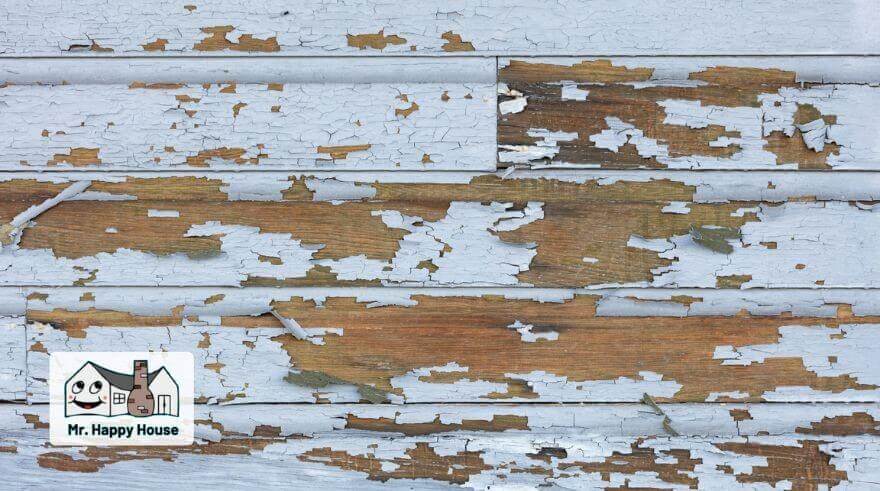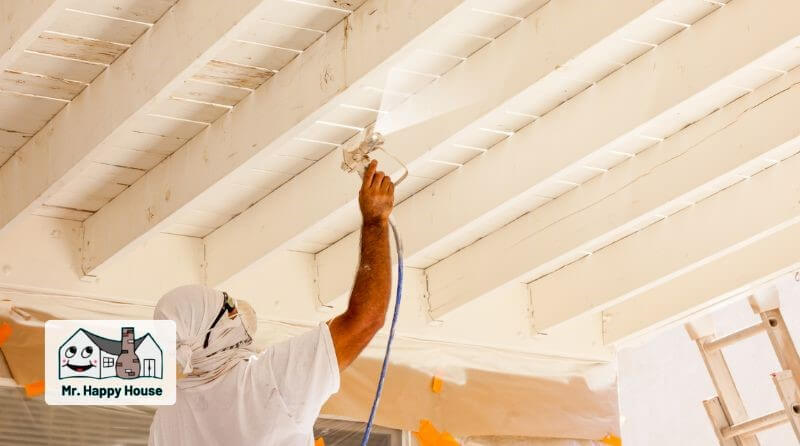
Best GAF Certified Roofers in The Woodlands, TX – Quality Roof Replacement, Gutters & Siding
Best GAF Certified Roofers in The Woodlands, TX – Quality Roof Replacement, Gutters & Siding Best GAF Certified Roofers in The Woodlands, TX – Quality

The enchantment of freshly painted walls or a rejuvenated exterior facade can breathe new life into any home. However, as time passes and the elements take their toll, that once-immaculate paint job can start to show signs of wear and tear. One of the most common and frustrating problems homeowners encounter is peeling paint. Whether it’s on the exterior of your house or within the cozy confines of your living room, peeling paint is not just an aesthetic nuisance but also a potential indicator of underlying issues.
In this article, we dive into the intricate details of why does paint peel, exploring the various causes behind this perplexing problem and, most importantly, offering practical solutions. From understanding the science of paint adhesion to learning how to undertake a successful paint restoration project, we’ll guide you through the steps necessary to restore your walls, ceilings, and exteriors to their former splendor.
So, if you’ve ever wondered why your paint is peeling and what you can do about it, read on to uncover the answers and regain the beauty and integrity of the interior or exterior of your home.
Poor surface preparation is a leading cause of paint peeling. Inadequate cleaning of surfaces before painting can allow dirt, dust, or contaminants to compromise paint adhesion. Properly cleaning surfaces with pressure washing or a soft wash method ensures that the paint can bond effectively. Additionally, insufficient priming is another critical factor.
In most cases for interior painting, priming serves as a foundation for paint and enhances its adhesion. Skipping the primer coat can result in poor paint adhesion and ultimately lead to peeling.
Lastly, for the exterior of the house, the lack of proper siding repairs contributes to peeling paint. Cracks, holes, or rotted wood trim or siding should be addressed before painting to ensure a smooth and stable surface for the paint to adhere to.
The quality of paint products used plays a significant role in preventing paint peeling. Trying to cut painting costs by using inferior-quality paint can lead to paint peeling as it may not form a durable bond with the surface.
It’s essential to choose reputable paint brands such as Sherwin Williams and other products known for their quality and longevity. Furthermore, applying paint with incorrect techniques can also result in peeling. Whether you’re using a brush, roller, or spray application, applying paint too thickly or unevenly can compromise its adhesion.
Proper application methods are crucial for a successful and long-lasting paint job. Finally, improper mixing or dilution of paint can affect its performance. Ensuring that paint is mixed and diluted correctly according to manufacturer guidelines is essential to prevent peeling.
Underlying structural issues within your home can contribute to paint peeling. One of the most common structural issues is water leaks and damage. Water infiltration can weaken paint adhesion and cause it to peel. Recognizing signs of water damage, such as stains or dampness, is crucial for addressing these issues promptly.
Additionally, pest infestations can damage painted surfaces. Preventative measures should be taken to protect against pests that can compromise the integrity of the paint. Lastly, structural problems with your home’s foundation or other components can affect paint. These issues should be addressed to prevent long-term paint damage.
Environmental factors, such as exposure to sunlight and UV rays, temperature fluctuations, and moisture levels, can all contribute to paint peeling. Ultraviolet (UV) exposure from the sun can break down paint molecules over time, leading to fading and peeling. Extreme temperature fluctuations can cause paint to expand and contract, ultimately weakening its adhesion.
High levels of moisture and humidity can also affect paint adhesion, particularly in areas like bathrooms and kitchens. Understanding these environmental factors and taking preventative measures, such as using proper ventilation or better quality paint can help mitigate the risk of paint peeling in different settings.
One of the first signs of paint peeling is changes in the texture of the painted surface. If you run your hand over the painted area and notice rough or uneven spots, it’s an indicator that the paint is starting to lose its adhesion.
Additionally, you might feel the sensation of loose or peeling paint when touched. These tactile clues can be early warnings that your paint is deteriorating and may require attention.
Keep an eye out for any changes in the color and sheen of your painted surfaces. Fading or discoloration of paint can be a clear sign that the paint is peeling or deteriorating.
Inconsistent sheen levels across the surface, where some areas appear shinier or duller than others, may also indicate issues with paint adhesion. Furthermore, if you notice a noticeable color mismatch between adjacent painted sections, it’s a strong indication that the paint may be peeling or wearing away unevenly.
Another reason why your exterior/interior paint is peeling is the edges and joints of painted areas, such as around doors, windows, corners, or seams. Peeling paint is often most visible in these areas because these specific areas are subject to more stress and movement. If you observe paint separation or peeling along these edges, it’s a clear sign that the adhesion between the paint and the surface is compromised.
Addressing peeling paint at edges and joints is crucial to prevent it from spreading further. This may also indicate wood rot if these signs show on wood surfaces.
In some cases, paint peeling can be associated with odors or mustiness. If you detect unpleasant or musty smells emanating from a painted surface, it could be an indicator of moisture-related issues beneath the paint. These issues may include water leaks or trapped moisture, which can contribute to paint peeling and should be investigated promptly. Understanding the connection between odors and paint peeling can help identify and address underlying problems effectively.
Before you can begin any painting project, whether it’s to repair peeling paint or for a fresh coat, proper surface preparation is paramount. To remedy peeling paint, start by inspecting the affected area.
Remove loose and peeling paint using a scraper or sandpaper. It’s crucial to create a smooth and stable base for the new paint to adhere to. Afterward, clean the surface thoroughly to remove dirt, dust, and any contaminants.
Repair any cracks or holes with filler and sand the surface to achieve a uniform texture. Proper surface preparation sets the foundation for a successful paint job and ensures that your efforts result in a long-lasting finish.
Choosing the appropriate paint is crucial to prevent future peeling and ensure durability. When addressing peeling paint, opt for high-quality exterior or interior paint, depending on the affected area.
Consider factors like the surface type, location, and climate conditions. Different paints are designed for various substrates, such as wood, metal, or masonry. Additionally, look for paints with good adhesion properties, as they will adhere better to the prepared surface.
By selecting the right paint, you can significantly reduce the risk of peeling in the future and enjoy a more resilient finish.
The application of paint plays a pivotal role in its longevity and resistance to peeling. Proper technique is essential to ensure even coverage and a smooth finish. Use the appropriate tools, such as brushes, rollers, or sprayers, based on the surface you are painting. Follow the manufacturer’s instructions for mixing if necessary.
With interior painting, apply paint in thin, even coats, allowing adequate drying time between each layer. Avoid overloading the brush or roller, which can lead to drips and uneven coverage. Proper application techniques will help you achieve a professional finish and minimize the chances of paint peeling prematurely.
Preventing future paint peeling is as important as addressing the current issue. To protect your investment and maintain the appearance of your surfaces, consider implementing preventive measures. Regular maintenance, such as pressure washing and inspecting your painted areas, can help identify issues early on. Keep an eye out for water leaks, cracks, or other structural problems that can contribute to peeling paint.
Address these underlying issues promptly to prevent further damage. Additionally, consider applying a primer before painting, especially on bare surfaces, as it improves adhesion and extends the life of your paint job. Finally, be mindful of environmental factors, such as sunlight, moisture, and temperature fluctuations, as they can impact the longevity of your paint. By taking preventive measures, you can enjoy a beautifully painted space for years to come.

Dealing with peeling paint is a task that can be undertaken as a DIY project, but there are situations where seeking professional help is the wisest choice. In this section, we will guide you through the decision-making process by considering your DIY skills and resources, understanding when it’s appropriate to hire a professional painting contractor, and factoring in budget considerations.
Before diving into a paint peeling project, it’s crucial to honestly assess your DIY skills and the resources at your disposal. Minor peeling in a small area with easily accessible surfaces may be well-suited for a DIY approach.
If you have experience with painting, the necessary tools and equipment, and extensive time to dedicate to the project, DIY can be a cost-effective solution. However, if the peeling is extensive, involves hard-to-reach areas, or requires significant surface preparation and repairs, it might be more practical to hire a painting company who has the experience, equipment, and manpower to tackle such challenges.
Knowing when to bring in professional painters or contractors is essential to ensure the best outcome for your peeling paint problem. Consider professional help if the peeling is widespread, especially on large exterior surfaces or high interior walls. Professionals have the expertise to assess the underlying causes of the peeling and address them effectively.
Additionally, if your project involves lead-based paint removal, asbestos containment, or other hazardous materials, it’s crucial to hire specialists who are trained in handling such situations safely. Ultimately, hiring professionals ensures that the job is done efficiently, with the right materials and techniques, and can save you time and potential headaches.
Budget plays a significant role in deciding whether to DIY or hire professionals for peeling paint remediation. DIY projects are generally more budget-friendly, as you can save on labor costs. However, it’s essential to weigh this against the potential risks and challenges you might encounter during the project.
Additionally, a professional painting contractor can complete the job faster, reducing the inconvenience, risk, and potential downtime. When making your decision, consider your budget constraints, the scope of the project, and the long-term benefits of a professional finish. Sometimes, investing a bit more upfront can lead to a more durable and aesthetically pleasing result, ultimately saving you money in the long run by avoiding premature paint failure and the need for frequent repaints.
In the quest for a beautifully painted exterior or interior, encountering peeling paint can be disheartening. However, armed with the knowledge and insights provided in this article, you now have a clear roadmap to address this common issue effectively.
We’ve explored the root causes of paint peeling and why does paint peel, from poor surface preparation to environmental factors, and discussed how to identify and remedy these issues. By understanding the importance of proper surface preparation, selecting the right paint, employing correct application techniques, and implementing preventive measures, you can significantly extend the life of your paint and maintain the aesthetic appeal of your space.
Furthermore, we’ve examined the decision-making process of whether to embark on a DIY journey or seek professional assistance. Assessing your DIY skills, considering the project’s scope, and factoring in budget constraints will guide you toward the most suitable choice.
Remember, paint peeling is not merely a cosmetic problem; it can signal underlying issues that need attention. By taking a proactive approach and following the steps outlined in this article, you can enjoy a well-maintained, beautifully painted space that stands the test of time.
In the end, addressing peeling paint is not just about aesthetics; it’s about preserving and enhancing the value of your home while creating a welcoming environment you can be proud of. With the right knowledge and a commitment to proper care, your exterior and interior paint can remain vibrant and durable for years to come.
We hoped you loved this article on the most popular house paint colors in Texas, please share and tune in for more and house painting content!
Our Services:













Best GAF Certified Roofers in The Woodlands, TX – Quality Roof Replacement, Gutters & Siding
Best GAF Certified Roofers in The Woodlands, TX – Quality Roof Replacement, Gutters & Siding Best GAF Certified Roofers in The Woodlands, TX – Quality

Are Gutters Part of the Roofing System?
Are Gutters Part of the Roofing System? Are Gutters Part of the Roofing System? When it comes to home maintenance, gutters often seem like a

Why James Hardie is The Best Option for Home Siding
Why James Hardie is The Best Option for Home Siding Why James Hardie is The Best Option for Home Siding James Hardie stands out whether











